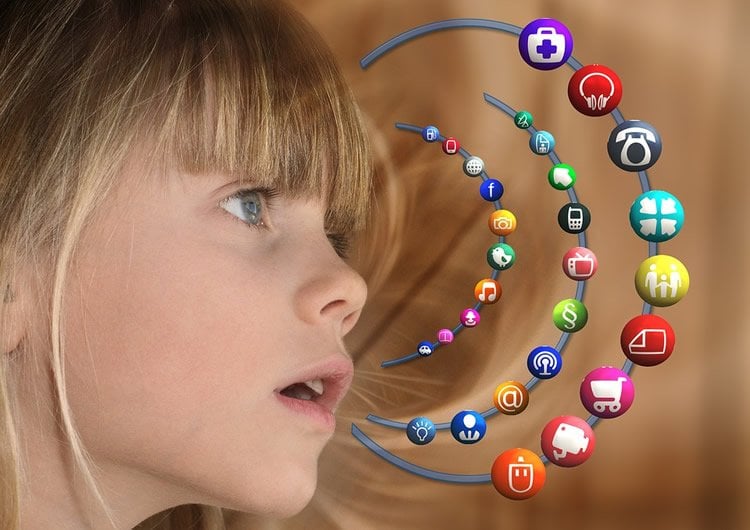Summary: A new study links increased time spent on social media by 10 year old girls to a decline in wellbeing at the age of 15.
Source: BioMed Central.
Social media use may have different effects on wellbeing in adolescent boys and girls, according to research published in the open access journal BMC Public Health.
Researchers at the University of Essex and UCL found an association between increased time spent on social media in early adolescence (age 10) and reduced wellbeing in later adolescence (age 10-15) — but only among girls.
Dr Cara Booker, the corresponding author said, “Our findings suggest that it is important to monitor early interactions with social media, particularly in girls, as this could have an impact on wellbeing later in adolescence and perhaps throughout adulthood.”
The authors found that adolescent girls used social media more than boys and social media interaction increased with age for both boys and girls. At age 13, about a half of girls were interacting on social media for more than 1 hour per day, compared to just one third of boys. By age 15, both genders increased their social media use but girls continued to use social media more than boys, with 59% of girls and 46% of boys interacting on social media for one or more hours per day.
Wellbeing appeared to decline throughout adolescence in both boys and girls, as reflected in scores for happiness and other aspects of wellbeing. Dr Booker said: “Since we did not observe an association between social media use and wellbeing among boys, other factors, such as the amount of time spent gaming, might be associated with the boys’ observed decline in wellbeing.”
The study used data from the youth panel of the UK Household Panel Study — a large national survey which interviews all members of a household annually, from 2009 — 2015. A total of 9,859 UK adolescents aged 10 to 15 years completed questions on how many hours they spent interacting on social media sites on a typical school day. The researchers assessed wellbeing among this cohort using two measurements: a happiness score built from questions about how happy they are with different aspects of their life including family and school, and the Strengths and Difficulties Questionnaire (SDQ), which measures negative aspects of wellbeing such as emotional and behavioural problems.

The authors found that throughout adolescence happiness scores dropped nearly three points from 36.9 to 33.3 in girls and two points from 36.02 to 34.55 in boys. While SDQ scores dropped for boys and increased for girls, indicating that girls experienced more negative aspects of wellbeing, the researchers concluded that overall wellbeing decreased for both.
The authors caution that because the study used the self-report data and only social media interactions on school days were recorded, the associations between social media and wellbeing may have been underestimated.
Source: BioMed Central
Publisher: Organized by NeuroscienceNews.com.
Image Source: NeuroscienceNews.com image is in the public domain.
Original Research: Open access research in BMC Public Health.
doi:10.1186/s12889-018-5220-4
[cbtabs][cbtab title=”MLA”]BioMed Central “Social Media Use at Age 10 May Reduce Adolescent Girls’ Wellbeing.” NeuroscienceNews. NeuroscienceNews, 20 March 2018.
<https://neurosciencenews.com/social-media-wellbeing-girls-8678/>.[/cbtab][cbtab title=”APA”]BioMed Central (2018, March 20). Social Media Use at Age 10 May Reduce Adolescent Girls’ Wellbeing. NeuroscienceNews. Retrieved March 20, 2018 from https://neurosciencenews.com/social-media-wellbeing-girls-8678/[/cbtab][cbtab title=”Chicago”]BioMed Central “Social Media Use at Age 10 May Reduce Adolescent Girls’ Wellbeing.” https://neurosciencenews.com/social-media-wellbeing-girls-8678/ (accessed March 20, 2018).[/cbtab][/cbtabs]
Abstract
Gender differences in the associations between age trends of social media interaction and well-being among 10-15 year olds in the UK
Background
Adolescents are among the highest consumers of social media while research has shown that their well-being decreases with age. The temporal relationship between social media interaction and well-being is not well established. The aim of this study was to examine whether the changes in social media interaction and two well-being measures are related across ages using parallel growth models.
Methods
Data come from five waves of the youth questionnaire, 10-15 years, of the Understanding Society, the UK Household Longitudinal Study (pooled n = 9859). Social media interaction was assessed through daily frequency of chatting on social websites. Well-being was measured by happiness with six domains of life and the Strengths and Difficulties Questionnaire.
Results
Findings suggest gender differences in the relationship between interacting on social media and well-being. There were significant correlations between interacting on social media and well-being intercepts and between social media interaction and well-being slopes among females. Additionally higher social media interaction at age 10 was associated with declines in well-being thereafter for females, but not for males. Results were similar for both measures of well-being.
Conclusions
High levels of social media interaction in early adolescence have implications for well-being in later adolescence, particularly for females. The lack of an association among males suggests other factors might be associated with their reduction in well-being with age. These findings contribute to the debate on causality and may inform future policy and interventions.






